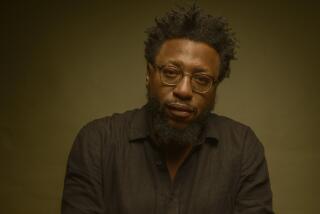Book review: ‘A Singular Woman: The Untold Story of Barack Obama’s Mother’
Janny Scott’s “A Singular Woman: The Untold Story of Barack Obama’s Mother” is driven by an unspoken tension — or maybe “question” is a better word. Reading it, we can’t help but wonder: How does one approach a biography about a private life?
By this, I don’t mean Stanley Ann Dunham was inconsequential, in the sense that none of us are inconsequential, that we are all living, breathing miracles of sentience, for whom, as Whitman wrote, “every atom belonging to me as good belongs to you.”
Yet while Dunham comes across in these pages as a smart and directed woman, ambitious and, in her own way, a devoted mother, we never lose sight of the fact that it is not what she did so much as who she raised that is important, that in her son’s unlikely journey to the presidency, her own life took on a meaning, and a resonance, that it might not otherwise have had.
Of course, when it comes to the president, that unlikely journey remains a source of contention, despite every effort, reasonable or otherwise, to put it to rest. Just last week, he gave in to three years of pressure and released his long-form birth certificate — not that it’s likely to mollify anyone on the fringes of the right.
For them, the account in “A Singular Woman” of Obama’s birth at Honolulu’s Kapi’olani Maternity and Gynecological Hospital will seem like just another piece of propaganda, as will Scott’s account of his childhood years in Indonesia, where his mother moved in 1967.
To her credit, Scott — a former reporter for both the Los Angeles Times and the New York Times who got interested in Dunham while writing about Obama during the 2008 campaign — doesn’t worry about this, treating facts as facts and moving on. More to the point is her intention to debunk an actual bit of mythology: Obama’s oft-repeated line, from his 2008 “More Perfect Union” speech, that “I am the son of a black man from Kenya and a white woman from Kansas.”
It’s not that this is untrue, in a manner of speaking, just that it’s not true enough. As Scott observes, “To describe Dunham as a white woman from Kansas is about as illuminating as describing her son as a politician who likes golf.”
So who was Stanley Ann Dunham? In Scott’s portrayal, she was tough and unconventional, aloof and occasionally distant, not unlike her son.
Born in 1942 in Kansas, she was the only child of peripatetic parents, who moved from the Midwest to California, and then to Oklahoma and Texas, before landing on Mercer Island, outside Seattle, where she attended high school. After graduation, the family settled in Hawaii.
Scott traces these migrations dutifully, if somewhat vaguely, since little information is available about her subject’s early life. As if to make up for that, she digs into family history, tracing Dunham’s lineage to the 19th century, to “farmers, teachers, abolitionists, Methodist ministers, Baptists, Civil War veterans, veterans of two world wars.”
The idea, clearly, is to establish Dunham as quintessentially American, giving her a backstory that is recognizable, complete. Yet more vivid is the image of a different kind of American family, the family Dunham created, essentially out of whole cloth.
“Yes,” Scott writes, “there was the white mother from Kansas and the black father from Kenya. Then there was the Javanese stepfather, Lolo Soetoro, with whom Obama lived for four years in Jakarta as a small child; there is President Obama’s African-American wife, Michelle, a descendent of slaves. There is his half-Indonesian half sister, Maya Soetoro-Ng; her Chinese-Canadian husband, Konrad Ng; and the president’s Kenyan and half-Kenyan half siblings scattered across the globe in places such as Nairobi and Beijing.”
Such a group, Scott notes, reflects a new sense of our aspirations, who we are and how we live. It took a substantial act of imagination to bring it into being, and this, perhaps more than anything, is Dunham’s legacy.
To highlight this, “A Singular Woman” explores Dunham’s years at the University of Hawaii and her studies at the East-West Center, an oasis of cultural and intellectual tolerance where she met both her husbands.
It follows her to Indonesia, where she lived on and off for a quarter-century, working first as an anthropologist (her PhD dissertation, based on more than a decade of fieldwork, examines peasant blacksmithing, a resilient cottage industry) and later as an aid officer for the Ford Foundation and a banking official specializing in microfinance.
Dunham was, Scott suggests, her family’s first community organizer, “an advisor on … rural credit … who also happened to be married to an Indonesian, fluent in the language and writing a thesis on small-scale industries.” Her efforts to help small, indigenous industries — especially those involving women — get access to necessary resources clearly had an influence on her son.
As he tells Scott, in an Oval Office interview, she was motivated by “a sense that beneath our surface differences, we’re all the same, and that there’s more good than bad in each of us. And that, you know, we can reach across the void and touch each other and believe in each other and work together.… That’s precisely the naiveté and idealism that was part of her.… And that’s, I suppose, the naive idealism in me.”
Still, for all the information Scott uncovers, “A Singular Woman” is missing something, a kind of center, a sense of Dunham as she was. Partly, that has to do with her reserve; even among friends, she didn’t often reveal herself.
Yet even more, it brings back the issue of private life, and whether a biography can ever do justice to an existence out of the spotlight, from which there are only fragments to reconstruct.
Again and again, Scott comes up against the limits of her information, relying too much on Obama’s memoir “Dreams From My Father,” sketching in details about significant events (the dissolution of Dunham’s two marriages; the circumstances of her death, in 1995, from uterine cancer). The material on cottage industries and microfinance is interesting, but it remains a bit abstract, with no emotional connection to compel us through the book.
Only when we see Dunham with her family does the narrative open, and such moments are few and far between. That, I suppose, is to be expected, given that one of Scott’s primary sources now lives in the White House, but it leaves “A Singular Woman” incomplete.
More to Read
Sign up for our Book Club newsletter
Get the latest news, events and more from the Los Angeles Times Book Club, and help us get L.A. reading and talking.
You may occasionally receive promotional content from the Los Angeles Times.








